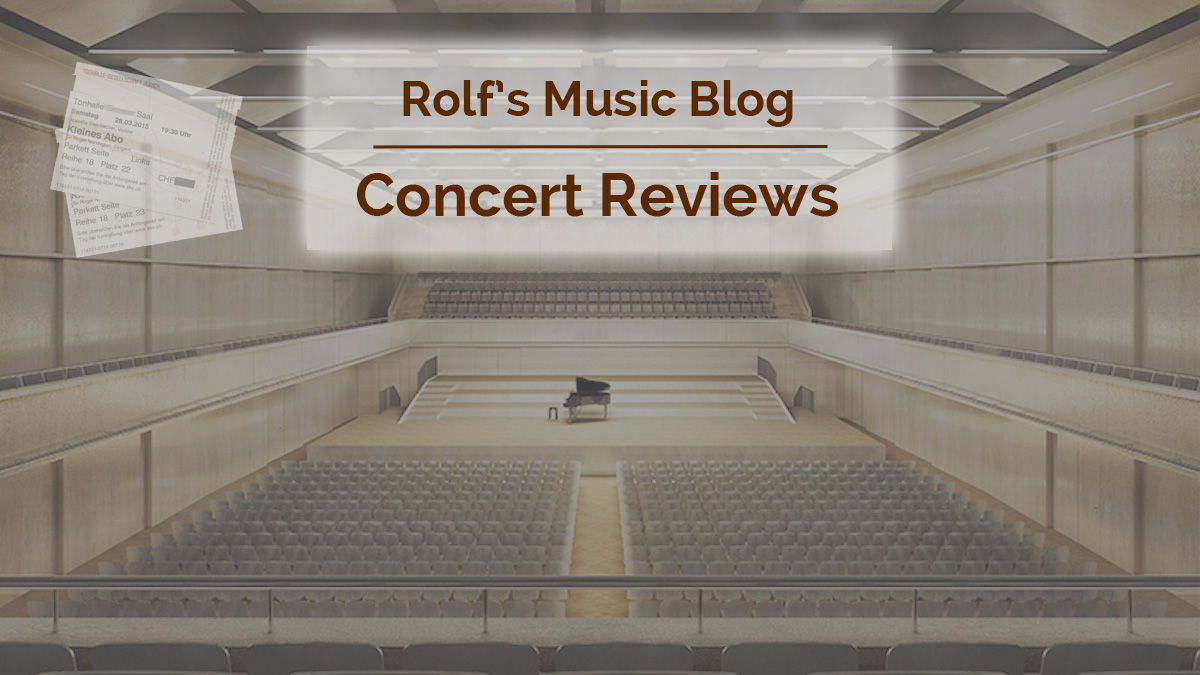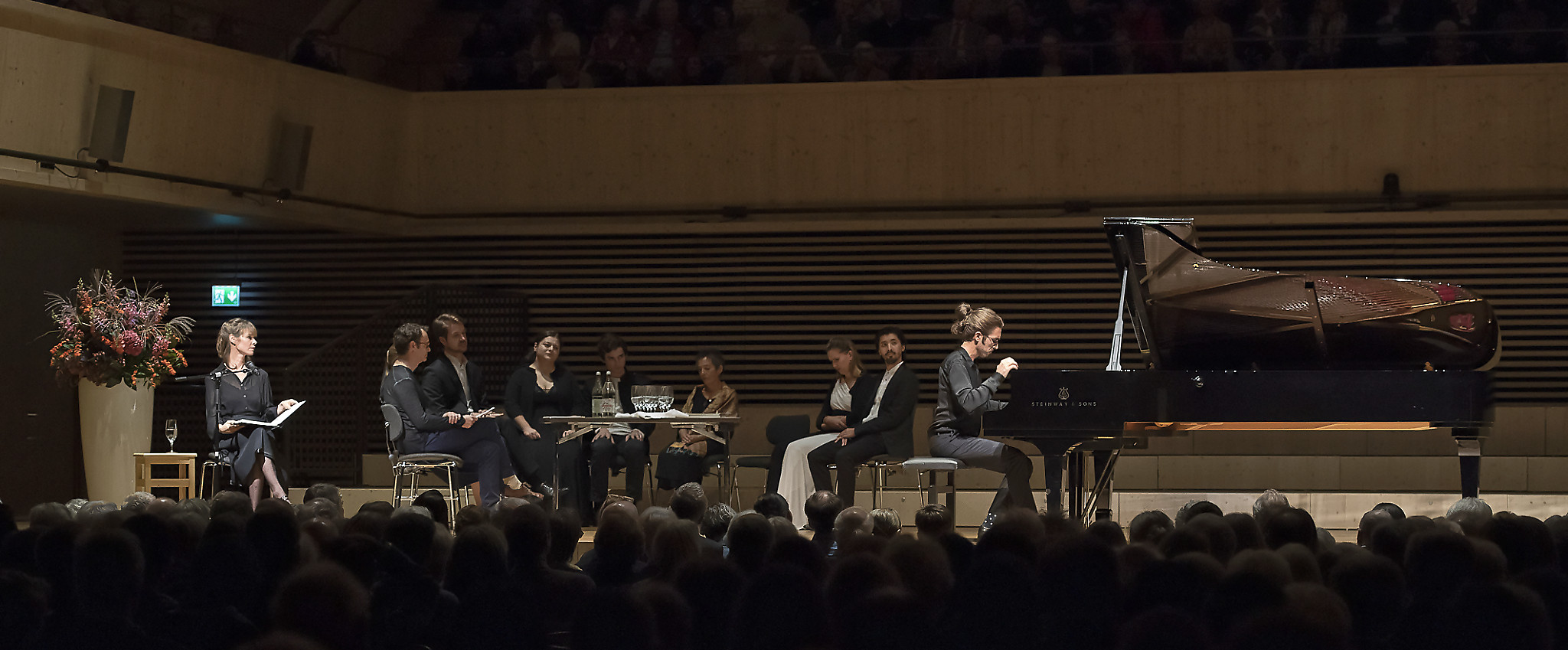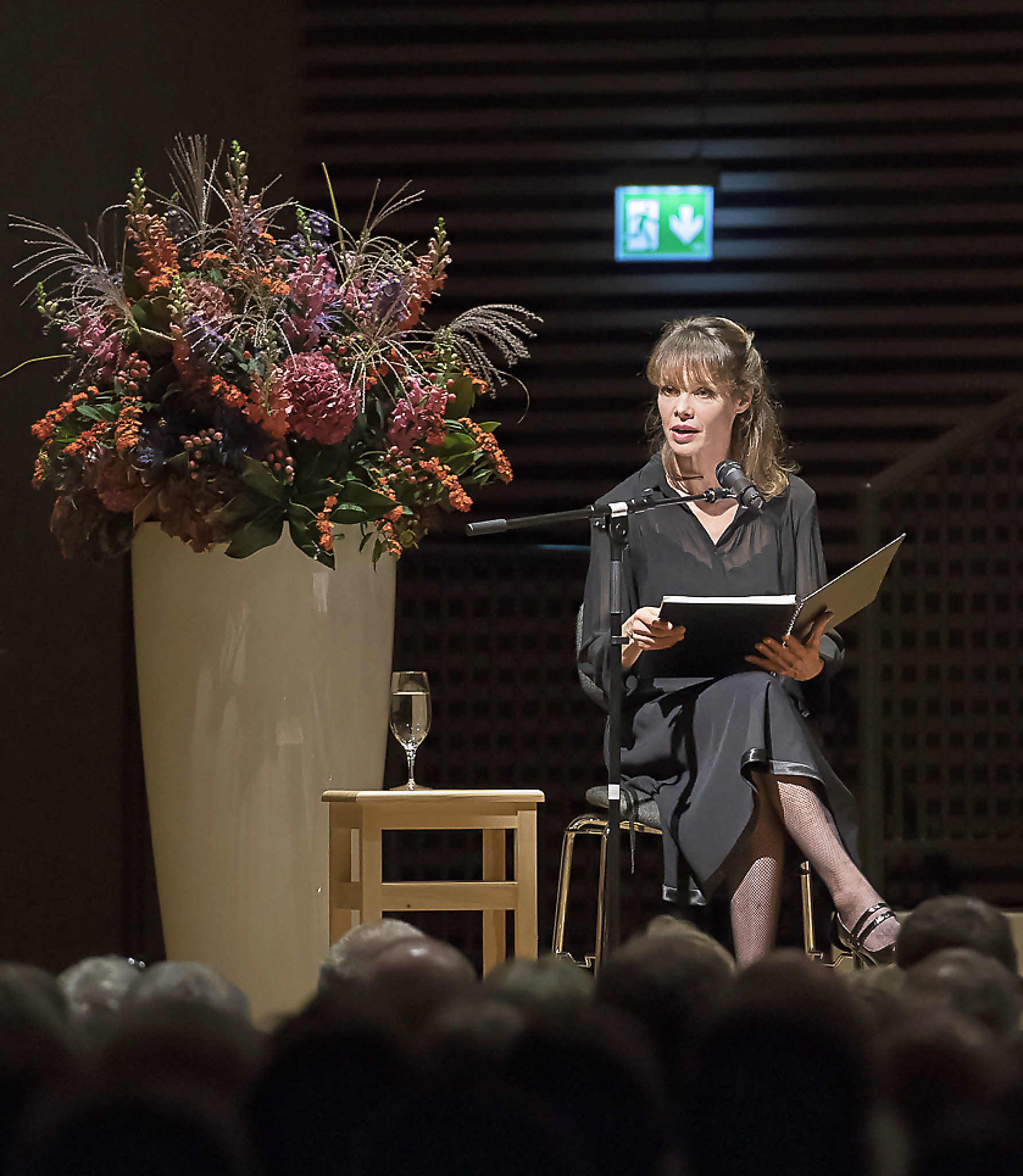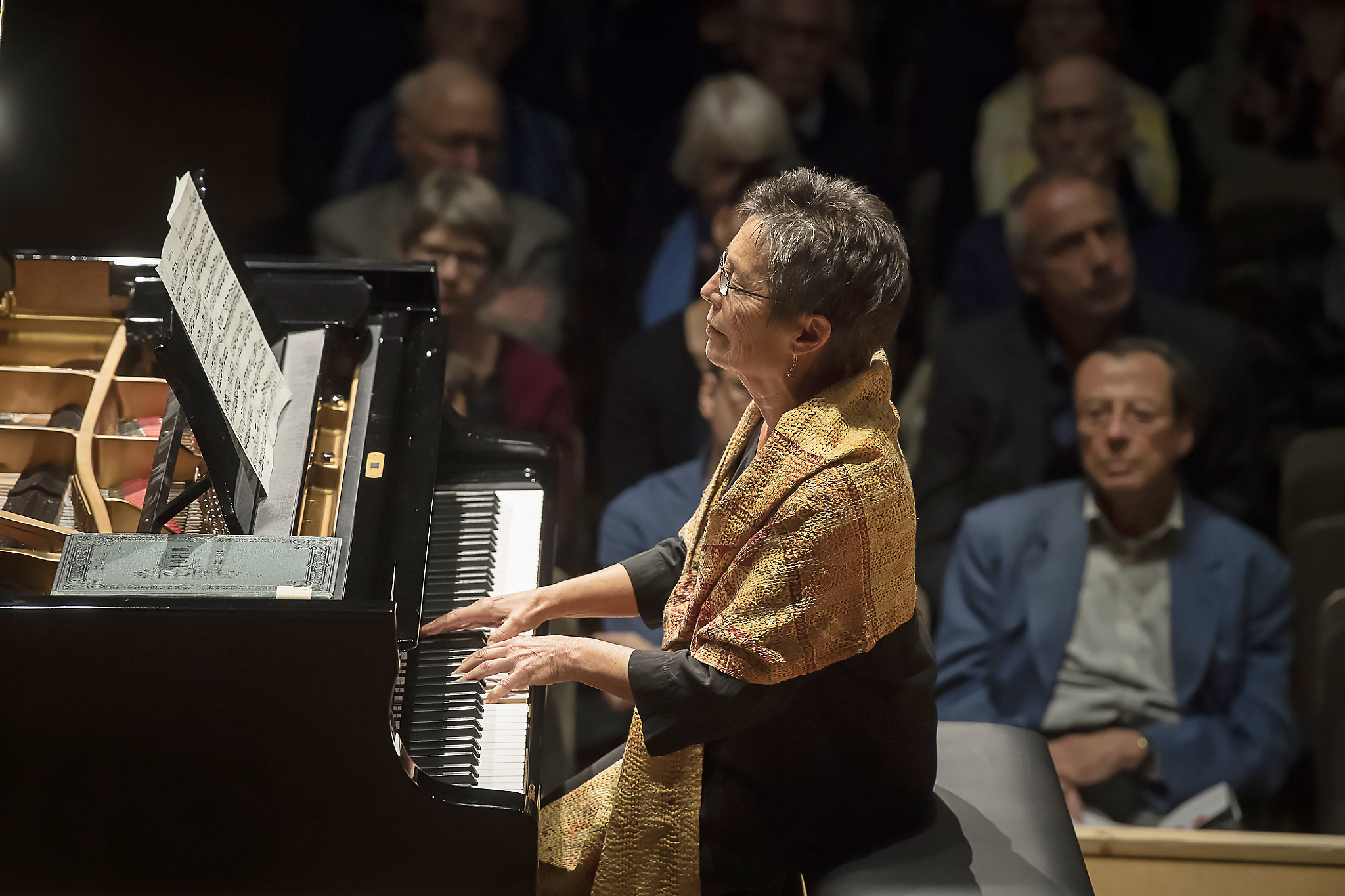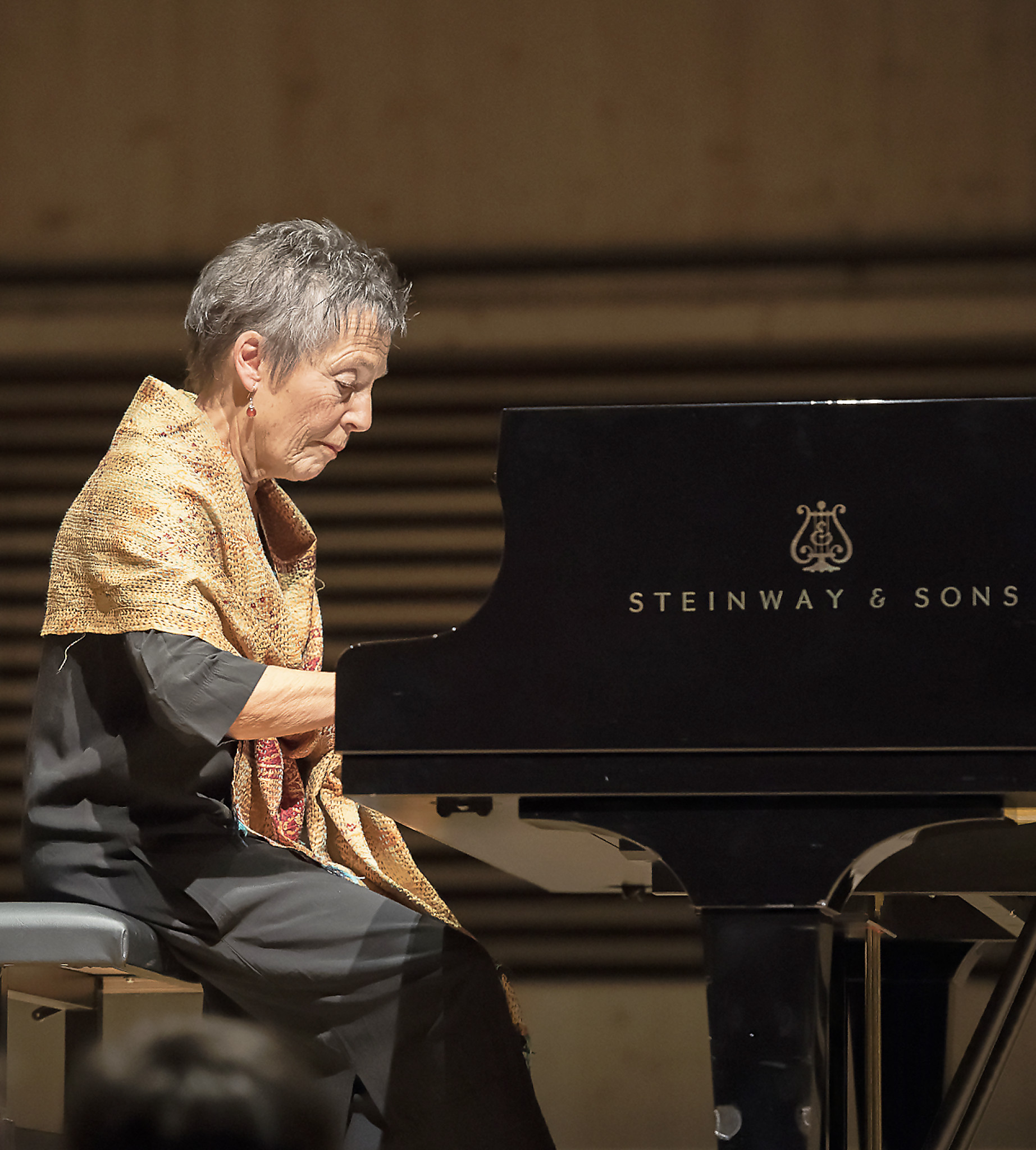Partitura Workshop & Orpheum Foundation with Pires & Popović
Bach / Chopin / Sounac
Tonhalle Maag, Zurich, 2018-11-02

2018-11-08 — Original posting
Orpheum, das Partitura Projekt, Maria João Pires, Raum und Zeit in der Musik — Zusammenfassung
Die Unterstützung durch die Orpheum Stiftung zur Förderung junger Solisten ermöglichte es der Pianistin Maria João Pires, das “Ergebnis” ihres diesjährigen “Partitura” Workshops in einem besonderen Rezital zu präsentieren. In ihrem “Partitura”-Projekt geht es um die “Erzeugung einer altruistischen Dynamik zwischen Künstlern verschiedener Generationen, die KünstlerInnen ihrer ästhetischen, ethischen, sozialen, pädagogischen und spirituellen Rolle und Verantwortung der Gesellschaft gegenüber bewusst werden zu lassen”.
Die Pianistin, die offiziell ihre Konzertkarriere beendet hat, wurde assistiert vom serbischen Pianisten Miloš Popović. Die beiden traten selbst mit je einem Werk von Bach und von Chopin auf. Dazwischen ergänzten Auftritte von Teilnehmern des Workshops—allesamt junge, viel versprechende Pianistinnen und Pianisten (Teo Gheorghiu, Annika Treutler, Giorgi Iuldashevi, Marta Cardoso Patrocínio, Marianna Uzankichyan, und Richard Octaviano Kogima) das Konzert zu einem sehr stimmungsvollen Anlass, in welchem sich Werke von Bach und von Chopin abwechselten. Die kurzen, ruhigen, nachdenklich-introvertierten Kompositionen wurden jeweils ergänzt durch Texte des französischen Schriftstellers Frédéric Sounac zum Thema “Raum und Zeit”, in Deutsch gelesen von der Schauspielerin Mona Petri. Dies ergab eine eindrückliche Dramaturgie. Es war äußerst anregend, zu hören und zu sehen, wie die Lyrik die Musik mal kontrastierte, mal komplementierte.
Table of Contents
- Introduction, Background
- The Concert Program
- The Performance — Stage Setting, Recitation
- The Music
- Bach: Well-Tempered Clavier I, Prelude and Fugue No.10 in E minor, BWV 855 — Maria João Pires
- Chopin: Mazurki , op.59 — Teo Gheorghiu
- Bach: Well-Tempered Clavier I, Prelude and Fugue No.12 in F minor, BWV 857 — Annika Treutler
- Chopin: Berceuse in D♭ major, op.57, CT 7 — Miloš Popović
- Bach: Well-Tempered Clavier II, Prelude and Fugue No.18 in G♯ minor, BWV 887 — Giorgi Iuldashevi
- Chopin: Nocturne No.14 in F♯ minor, op.48/2, CT 121 — Marta Cardoso Patrocínio
- Bach: Well-Tempered Clavier I, Prelude and Fugue No.18 in G♯ minor, BWV 863 — Miloš Popović
- Chopin: 24 Préludes , op.28 — Marianna Uzankichyan
- Chopin: Nocturne No.3 in D major, op.9/3, CT 110 — Maria João Pires
- Bach: Well-Tempered Clavier I, Prelude and Fugue No.4 in C♯ minor, BWV 849 — Richard Octaviano Kogima
- Conclusion
Introduction, Background
Concerts that the Orpheum Foundation for the Support of Young Artists organizes typically run under the title “Orpheum — Young Soloists on Stage“. Most of the Orpheum concerts are symphonic concerts in which young artists (recipients of support by the foundation) perform in a classical, romantic, or 20th century concerto. However, this evening was very different. There was no orchestra, no conductor, just soloists—and a workshop that preceded the concert:
Maria João Pires and the “Partitura” Project
2012, the Portuguese pianist Maria João Pires (*1944) founded the “Partitura” Project. This is a movement / organization / project that the concert handout describes as follows (freely translated):
A movement with the goal of creating an altruist dynamism between artists from different generations. These artists (are meant to) challenge their role and their responsibility—be it esthetic, ethical, social, pedagogic, or spiritual—towards the society. In an environment in which most human values appear to be in a crisis situation, the Partitura movement aims at enabling an open dialog between the various artistic and scientific tendencies. This dialog should give people a better understanding for society, for their surroundings. All activities of the Partitura Project occur under the hood of the “Association Partitura” in Switzerland.
2017, Maria João Pires announced her retirement from the concert stage. See my report from one of her last concerts in Zurich, on 2017-12-20. However, her work with the “Partitura” Project continues. Right from the beginning of the project, Maria João Pires actually worked with an assistant, the Serbian pianist Miloš Popović (*1985). In the framework of the project, Popović accompanies her throughout Europe.
The “Partitura” Workshop 2018
This year, for the first time, the Orpheum Foundation cooperated with the “Partitura” Project—not only in organizing this concert, but also the 1-week workshop that preceded the public recital at Zurich’s Tonhalle Maag. In that workshop, several promising, young artists worked with Maria João Pires and Miloš Popović over a week.
As a result of the workshop, Pires, Popović, and six participants presented compositions by Johann Sebastian Bach (1685 – 1750) and by Frédéric Chopin (1810 – 1849) in this recital. In the order of their appearance, the participants of the workshop were the pianists
- Teo Gheorghiu (*1992, Switzerland, see also Wikipedia)
- Annika Treutler (*1990, Germany, see also Wikipedia)
- Giorgi Iuldashevi (*1995, Tbilisi/Georgia)
- Marta Cardoso Patrocínio (*1994, Porto/Portugal)
- Marianna Uzankichyan (*1991, Yerevan/Armenia)
- Richard Octaviano Kogima (*1990, São Paulo/Brazil)
For once, I don’t give details on the artists’ biographies. One small exception: for a Swiss audience, one pianist stood out from the other workshop participants, Teo Gheorghiu. This name is familiar from his participation in the Swiss film “Vitus” (2006), and from numerous appearances on concert stages. I have written about one of his recitals, three years ago, on 2015-10-31, in Baden/CH.
The Concert Program
As mentioned, the concert featured compositions by Johann Sebastian Bach and Frédéric Chopin. The following compositions were played (shown in the approximate order of creation):
Johann Sebastian Bach (1685 – 1750):
- Preludes and Fugues from The Well-Tempered Clavier, Volume I:
- Preludes and Fugues from The Well-Tempered Clavier, Volume II:
Frédéric Chopin (1810 – 1849):
- Nocturne No.3 in D major, op.9/3, CT 110
- 24 Préludes, op.28:
- Nocturne No.14 in F♯ minor, op.48/2, CT 121
- Berceuse in D♭ major, op.57, CT 7
- Mazurka No.36 in A minor, op.59/1, CT 86
- Mazurka No.37 in A♭ major, op.59/2, CT 87
The order of the pieces in the performance was different from the one above. The links in the list point to the appropriate section in the performance notes below. Wikipedia links for the pieces are given in the performance notes.
The Performance — Stage Setting, Recitation
Prior to the concert, Maria João Pires and Miloš Popović had prepared and worked with the workshop participants on the pieces in this recital. They now jointly presented these in the concert, under the abstract title “Space and Time in Music
It was not a series of performances, but one single, joint recital, running through, without intermission. All participants were present on the podium at all times, to the left of the piano, sitting in a semi-circle, around a table. One by one, the artists—including Maria João Pires and Miloš Popović, left the group, sat down at the piano for his/her performance, then returned to the semi-circle.
Whenever an artist’s performance ended, the Swiss actor Mona Petri (*1976) seamlessly started reciting texts (poems) by the French author Frédéric Sounac (*1969), in translations by Nadia Lapchine and Mechthild Coustillac.
The recitations filled the space between two musical appearances, forming one single, seamless performance from the first piece to the last one. The insertion of these texts was a suggestion by Maria João Pires. She knows the author. Frédéric Sounac even has written the book “Une Saison à Belgais autour de Maria João Pires“ (Éditions Aedam Musicae, 2015, ISBN 978-2-919046-25-6), in which Sounac wrote “a fragmentary chronicle about 10 years of experience at the Center for the Study of Arts in Belgais (Portugal), an institution that Maria João Pires founded”.
The physical movements of the artists were all silent, calm, pensive / reflective. No applause interrupted the flow of music and texts. Even if the texts, the recitations intermittently were dramatic / emotional, the atmosphere remained solemn, intimate, ceremonial—and spellbinding, for almost 90 minutes.
Overall Concert Layout
The artists appeared in the following order:
- Maria João Pires — Bach (BWV 855)
- Teo Gheorghiu — Chopin (Mazurki)
- Annika Treutler — Bach (BWV 857)
- Miloš Popović — Chopin (Berceuse)
- Giorgi Iuldashevi — Bach (BWV 887)
- Marta Cardoso Patrocínio — Chopin (Nocturne op.48/2)
- Miloš Popović — Bach (BWV 863)
- Marianna Uzankichyan — Chopin (Préludes)
- Maria João Pires — Chopin (Nocturne op.9/3)
- Richard Octaviano Kogima — Bach (BWV 849)
Texts by Frédéric Sounac
The texts were described as poems—however, certainly in the German translation they sounded like prose, forming one single narration throughout the performance.
I can’t and don’t want to reproduce the content of the narration here. For a listener who focused on the musical performance (like myself), it wasn’t necessarily easy to keep track of the overall course of action. Let me just dig in my vague memory: several of the segments were about a dialog with (or rather a monologue about) a musician. A mother talking to / worried about her musician son?
The context is a dream, or rather a nightmare, about an (upcoming / ongoing, imagined) examination or competition situation. As typical for dreams, associations lead the narrator into exam situations in Wagner’s Parsifal tale. There are sudden, unexpected obstacles, inexplicable, surreal, labyrinthine complications, dream in a dream—dream or daydream?
The text obviously had no direct connection with the music in the program, other than (?) emotional / dramatic contrast. Presumably, it was meant to related to the situation of the young artists. In the last segments, it did touch upon the question of space and time (in music), and it all ended with the question “What is music?”.
Presentation
The recitation (language, diction) was excellent, vivid, dramatic, but never raising the voice to overpowering level. From time to time, there were illustrative interjections (like a fragmentary soundtrack, exclamations, echoing by one of the dream figures) from within the semicircle of artists. Some of these brief interjections were in French, which gave the presentation an interesting twist.
The Music
Some words on the Bach pieces: Bach wrote the two times 24 Preludes and Fugues in the two volumes of the Well-Tempered Clavier (Das Wohltemperierte Clavier) with a baroque keyboard instrument (clavichord or harpsichord) in mind. This means, that in the original form virtually all expression goes into articulation. There is very limited (clavichord), if any (harpsichord) dynamic variation, other than possibly switching to a different stop / keyboard (harpsichord). And on a harpsichord dynamic changes therefore are discrete, not continuous.
Obviously, it was better not to impose “historic” expectations on the performances in this recital, for several reasons:
- The modern concert grand (Steinway D-274) is vastly different in sound and articulation. And the use of at least moderate dynamics is simply a given.
- None of the artists (to my knowledge) has a (public) record of performing on historic instruments—they all grew up and live in the classic & romantic repertoire.
- Maria João Pires’ own, personal performance style (and strength) is about subtlety in dynamics, articulation and phrasing, about depth in expression / emotions.
- Finally, none of the selected pieces by Chopin was eruptive and passionate (as his Scherzi, or the Ballades): the focus was on emotional depth, reflection, warmth.
Last, but not least: the program alternated between Bach and Chopin, forming an overall “Choreography”, along with the text segments. Such alternation only makes sense if the sections “interact” with each other, ultimately forming a harmonious ensemble.
Bach: Well-Tempered Clavier I, Prelude and Fugue No.10 in E minor, BWV 855 — Maria João Pires
Maria João Pires opened the recital in a calm atmosphere, articulating softly, not pushing the tempo in the prelude. She kept the left hand accompaniment restrained, focusing on the singing in the top cantilena. Her agogics were rich, the dynamics , the phrasing in the right hand very subtle. Trills and other ornaments sounded unexcited, like written out in demisemiquavers. And over the entire first part of the Prelude, she formed a beautiful, emotional arch, at the same time building up expectation. The latter harmoniously (not abruptly) discharges into the fluent Presto segment: not a sporty performance, just the culmination of the movement, with a gentle rallentando towards the closing fermata.
The following, two-voice fugue focused on harmonious flow, and on forming one single, dramatic arch. The tempo felt very natural—for a modern concert grand: on a harpsichord, this is typically much slower and more detailed in articulation. Here, the most prominent feature in articulation was the staccato in the intermittent quaver figures in the secondary theme. This also gave the fugue some additional internal structure.
★★★★½
Chopin: Mazurki, op.59 — Teo Gheorghiu
Mazurka No.36 in A minor, op.59/1, CT 86
An excellent performance! Gheorghiu’s basic tempo was fluent, though flowing in waves, alternating between brief accelerations and hesitation, with rich rubato, as well as distinct agogics—all so typical of a Mazurka! And despite all the agogic detail, Teo Gheorghiu resisted the temptation to push, took his time, shaped the dynamic waves into a big overall, dramatic arch. And throughout, he kept the slightly melancholic, indecisive, if not moody Mazurka atmosphere.
Mazurka No.37 in A♭ major, op.59/2, CT 87
Here, the atmosphere seemed serene, if not joyful at first—but it didn’t take long for the melancholic trait to return. The pianist carefully shaped the dynamics in Chopin’s 4- and 2-bar phrases. It was particularly outstanding how he harmoniously formed a decrescendo in closing the phrases. And he did not dissect the music into motifs, but kept an eye on the overall, big arch. Excellent, atmospheric and conclusive performance also here—congrats!
★★★★★
Bach: Well-Tempered Clavier I, Prelude and Fugue No.12 in F minor, BWV 857 — Annika Treutler
The F minor prelude appeared in a fluent tempo, forming soft, big arches. Maybe sometimes slightly heavy in the short notes and ornaments, also pushing forward a tiny bit: it seems so simple, yet is so difficult!
The fugue starts entirely calm, initially p or pp, with soft articulation, gradually building up volume, Legato, forming big arches, growing in dynamics, along with the density of the fugue texture. Annika Treutler kept the calm though the arches, and the performance closed with a gentle broadening.
★★★½
Chopin: Berceuse in D♭ major, op.57, CT 7 — Miloš Popović
What a nice and touching piece the Berceuse is—it can hardly fail! The basic pace was fluent, though still natural, with rich agogics, occasionally turning dreamy, pensive. Miloš Popović’s performance lived mostly from the right hand, the melody in the descant with its garlands, the rich figurations. At the tomes, the left hand almost retracted into a kind of murmuring in the underground. A very atmospheric performance with a soft, but highly intense, touching ending. My only quibble: I felt that the descant sound a tad too bright, while at the same time, the bass sometimes seemed to lack some warmth, sonority. Was this due to the intonation of the instrument? I can’t tell.
★★★★
Bach: Well-Tempered Clavier II, Prelude and Fugue No.18 in G♯ minor, BWV 887 — Giorgi Iuldashevi
In some aspects (especially in the beginning of the prelude), I distinctly felt Pires’ “handwriting”—e.g., in the soft arches in every phrase, the initially gentle dynamics. However, to me, the shaping of the small-scale motifs sometimes felt a bit mechanic, as if the piano mechanics were a bit heavy. I also found it to be too expansive in dynamics (particularly so in the second part), too direct: a romantic interpretation? Far from Bach’s original.
I liked the fugue better, even though some of the above reservations also applied here. In particular: the flow of the theme, and how every occurrence of the theme formed a long phrase. I also enjoyed the narrating articulation & phrasing, the big dynamic arch, how dissonances in the climax stood out, the final build-up.
★★★ / ★★★½
Chopin: Nocturne No.14 in F♯ minor, op.48/2, CT 121 — Marta Cardoso Patrocínio
A restrained beginning that seemed to evolve from the underground. Then, the right hand started to sing, led the music forward, driven by the broken chords in the left hand. Wonderful arches, and a big breath—it almost forced the listener to breathe with the music! Then, the piece suddenly modulates to D♭ major—a window to another world seemed to open. And still / again: the pianist showed the breathing in this music, in dynamics, in the rubato. The interpretation built up to a broad climax, calmed down, almost unexpectedly, we found ourselves back in the world of the initial F♯ minor, the breathing now more in every bar, as if the composer was out of breath from the emotional turmoil. Another excellent performance, consistent, rich, closed in itself!
★★★★½
Bach: Well-Tempered Clavier I, Prelude and Fugue No.18 in G♯ minor, BWV 863 — Miloš Popović
In the short prelude, Miloš Popović focused on the big overall arch, keeping the music, the flow simple—not straight, but harmonious. Was it the contrast from the preceding Nocturne, or memory from performances on the harpsichord that made me wish for richer articulation, more detail at the level of motifs?
The theme of the fugue had much more detail in the articulation. Also here, Popović focused on the dynamic arches, both for every occurrence of the theme, as well as following the density of the polyphonic texture. Down-to-earth Bach, without mannerisms.
★★★ / ★★★★
Chopin: 24 Préludes, op.28 — Marianna Uzankichyan
Prélude No.13 in F♯ major, op.28/13, CT 178
Very restrained initially, with a rather slow tempo, which makes following the “melody” in the right-hand chords very hard. The pianist combines smaller groups of bars into nice phrases. This may be one possibility for this Prélude—though, I felt that this was at the expense of the big, overall melody / phrase. Compared with a typical faster interpretation, this seemed to lack overall flow, but had an excess in “local detail”. Yes, there was a big build-up and arch starting at the Più lento—but the melody somehow was missing out from this. An overly romantic view?
Prélude No.14 in E♭ minor, op.28/14, CT 179
The only dramatic piece in the concert—though only very short, of course. The pianist no doubt has the technical means for this music. Though, I felt that the performance suffered from excess pedal, which made this brief intermezzo fairly blurred.
Prélude No.15 in D♭ major, op.28/15, CT 180, “Raindrop prelude”
The third of the selected Préludes is the most popular of all—but also a challenging piece.There was sometimes a little too much unrest. To some degree, this diminished the effect of the overall, dramatic build-up. I also noted an occasional lack of patience to retain the pace ahead of a local climax. The little cadenza at the smorzando, though, had beautiful agogics! In general, Marianna Uzankichyan carefully and consequently followed the dynamic arch, formed lyrical melodic phrases, remained subtle in the touch: (mostly) harmonious breathing in and with the music.
★★★½ / ★★★ / ★★★½
Chopin: Nocturne No.3 in D major, op.9/3, CT 110 — Maria João Pires
This wasn’t the end-point of the concert—but the clear highlight of the evening! A performance with almost extreme agogics, so much life in the small motifs and phrases—and yet, there were the big arches. Life and narration at every level, imaginative, visionary! Yes, there are eruptions—but the music retains its harmonious, organic breathing. And after every eruption, Maria João Pires picks up the thread if the narration again. Nothing is superficial or peripheral in this interpretation of a big mind—simply masterful, and very touching, a real gift to everybody!
★★★★★
Bach: Well-Tempered Clavier I, Prelude and Fugue No.4 in C♯ minor, BWV 849 — Richard Octaviano Kogima
It can’t be a desirable situation to end a concert / recital after a master performance such as Maria João Pires’ Nocturne! I suspect that the original plan had Pires’ performance at the end. However, she may have insisted in not being the last performer? This not only broke the pattern of alternating Bach and Chopin performances, but it also left Richard Octaviano Kogima with the impossible task of trying to match up Chopin’s early masterpiece with baroque music that is so different in style and character.
In the prelude, Kogima’s playing was very subtle. However, I found it overly romantic with its soft articulation and phrasing in dynamic and agogic arches, the strong ritardando at the end.
The fugue is more than that: a five-voice double fugue, a complex masterpiece. As such, one may see it as a worthy end-point to the journey of this concert / recital. Richard Octaviano Kogima no doubt shaped his performance very carefully, with impressive and harmonious build-up arches. He has all the technical prowess to master Bach’s complex, dense texture with its many layers. At the same time, it was another, very romantic view on Bach. this was most striking in the extreme rallendando and decrescendo over the last bars, ending in a big, romantic question mark. One may see it as mirroring the final question “What is music?” in Sounac’s text? I felt that is too strong an exploit for the purpose of the overall dramaturgy—and very, very far from Bach’s original.
★★★ / ★★★½
Conclusion
I may not agree with all of the musical performances—at the same time, I can’t emphasize enough that I regard the recital, the evening as a huge success overall. It was impressive in its dramaturgy, the musical journey, how the lyrics contrasted, complemented, and finally still matched up the music. And how the seemingly monotonous alternating sequence of compositions by Bach and Chopin ended up as a sensible overall sequence—thanks to the “mediating glue” of the texts by Frédéric Sounac.
The scope of the pieces in the program was limited: most of Chopin’s pieces are reflective, if not introverted. Bach’s preludes and fugues seemed to match that selection well. However, one may claim that some of the Bach pieces were “bent” to match the romantic context. In any case, with almost every performance, one seemed to “feel” Maria João Pires’ influence, her model & philosophy. And I don’t think this was because in the presence of the master, the workshop participants purposefully imitated Pires’ role model. Rather, I think that Pires has successfully conveyed her philosophy in music and life to the young artists. They may not (and probably should not) apply this to all their future performances—but I’m sure that their encounter with Pires has had a lasting effect on them.
We have experienced a number of interesting, young artists—not all at the same level (yet), but most or all with the potential for a successful career. And we have had the chance for a heart-warming, impressive and touching “post-career” encounter with one of the great artists of the past decades!
Acknowledgements, Credits
The author would like to express his gratitude to
- the Orpheum Foundation and Goldmann PR for the invitation to the concert
- Goldmann PR for forwarding the photos from the concert
With the exception of the artists’ press images at the top, all photos are © Thomas Entzeroth, Zürich.

